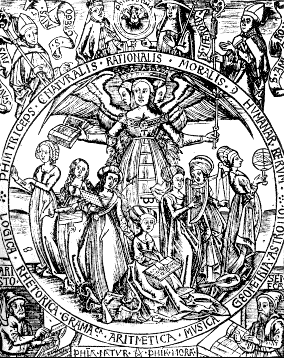Based on the types of studies that were pursued in the Classical world, the Seven Liberal Arts became codified in late antiquity by such writers as Varro and Martianus Capella. In medieval times, the Seven Liberal Arts offered a canonical way of depicting the realms of higher learning.
The Liberal Arts were divided into the Trivium ("the three roads") and the Quadrivium ("the four roads").
The Trivium consisted of:
The Quadrivium consisted of:
The medival Quadrivium thus followed the division of mathematics made by the Pythagoreans. Recently, mathematics has been defined as "the study of patterns in space and time," which very much resembles the ancient Pythagorean understanding of mathematics.
There were other important studies in medieval times. For example, philosophy was often envisioned as a metastudy that united all branches of knowledge. For this reason, Philosophia is depicted in the illustration below as nourishing the Seven Liberal Arts.

David Fideler -- April 27, 1996
Copyright information